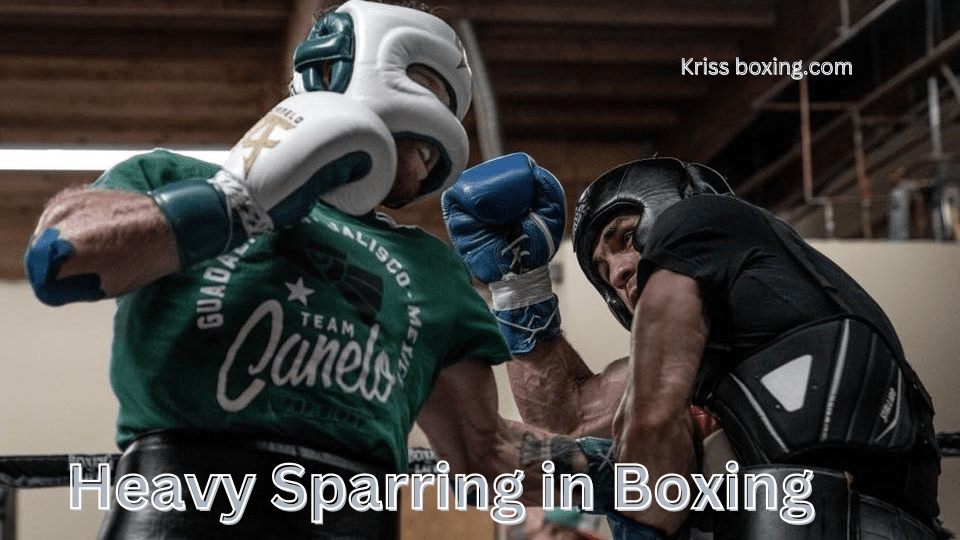Heavy sparring unlike light sparring, is a practice session in boxing when two boxers are allowed to deliver forceful and realistic punches on each other during exercise sessions.
This is considered as one of the key training techniques necessary for achieving set goals of molding champions through skills, tenacity, and bearing in equal tenets of the ring.
Indeed, it entails numerous risks that have to be minimized to avoid causing harm particularly when the opponent is too strong.
Therefore, the purpose of this article is to discuss the advantages and disadvantages of heavy sparring and to give recommendations as to how it can be used in boxing practice.
Building Fight Readiness
Intensive fighting is perhaps the most potent practice that can be used to pave the way for a fight in the box.
Due to the increasingly hard-hitting nature of boxing bouts, such drills prepare boxers psychologically and physically for the real thing.
Heavy sparring allows fighters to:
- Enhance Reflexes and Timing: Mentioning, full-contact sparring increases a boxer’s sense of time and reaction to his or her competitor’s actions.
- Conditioning: The general escalated practice increases the cardiovascular and muscular fitness preparing the boxer for the fight.
- Experience: Sparring at high intensity offers the individual significant practice, which prepares the boxer for feeling the blows giving them, the distance sensations and maintaining one’s composure when one is under pressure.
- Technique Application: It allows a fighter to use the techniques taught during training in real-life situations so that the fighter will be able to improve on the tactics used.
- Mental Toughness: In heavy sparring sessions one can face a live counter puncher and it helps in building the character of a boxer and keeps the mind focused and determined always whether the boxer is tired or injured.
Preparing for Specific Opponents
Heavy sessions can also be done in such a way that they aim at the opponent one is preparing to face.
The concept of emulation allows fighters to study the characteristics of a scheduled opponent and rehearsal tactics that target the opponent’s weaknesses while avoiding his/her special skills.
Targeted preparation of such conditioning can therefore be of immense value for a person who is participating in boxing competitions.
Physical Risks
Despite the advantages of engaging in heavy spar, it has many drawbacks mainly health-wise, which must always be well dealt with. These risks include:
- injury: The most direct trade-off I foresee is the fact that heavy sparring tends to bring out the use of vices. Physical misfortunes are common and may range from mere cuts and bruises to cracked ribs and other injuries that affect a boxer’s preparation and fighting ability.
- Concussions and Brain Damage: The blows they receive during heavy sparring sessions may result in shock and other serious mental complications such as CTE.
- Overtraining: Excessive intensive training proves counter-productive and decreases a boxer’s efficiency; it also shortens the time between bouts increases muscle injuries; and even affects his general health.
Mental and Psychological Risks
Heavy sparring can also have psychological effects which are:
- Burnout: Heavy sparring entails both physical and mental exertion therefore, if a trainer takes his boxer through rigorous sparring sessions they may get out of morale or they get tired mentally.
- Loss of Confidence: If a boxer experiences struggle or is overwhelmed during heavy spar he/she is likely to be discouraged and lose that self-belief which was so vital for him/her to carry out the spar.
- Desensitization: Long training with heavy sparring may lead to the reduction of the natural reaction of the fighter towards punches, a situation not good, especially in fights.
Balancing the Benefits and Risks
Heavy sparring can be assumed as the type of training that should be maximized to achieve the benefits, cause there is always a way to control and adjust the future training, to reduce the negative consequences of it. Here are some tips:
- Frequency and Intensity: Minimize the number of intensive punching practices to avoid setting up bad habits to do with overtraining and avoid common injuries. Training sessions should provide the feel of a real fight but should be regulated to an extent that out-of-bounds blows are not dealt.
- Protective Gear: It is highly advisable to wear proper protective gear such as headgear, mouth guards, and proper type of gloves to minimize possible injuries.
- Supervision: Heavy attacks should always be directed under the supervision of the trainer who observes the level of impact force, monitors the forms of the fighters, and halts the bout in case of necessity.
- Rest and Recovery: Ensure that they sufficiently rest and recuperate from the intense training episodes to permit the body and mind to recover.
- Feedback and Reflection: Post every session, debrief with a coach with regards to the sparring performance to extrapolate the strengths and weaknesses and be certain that the sparring sessions are beneficial to the players in one way or another.
Frequently Asked Questions
Is heavy sparring necessary for all boxers?
Intensive training is normally good for every boxer, particularly those preparing for the competition. However, it should be adapted to the skills and objectives that the person has within the corresponding sphere. Light contact may also be applied to beginners since the trainer ought to be careful when evaluating that fighter until the latter establishes the base.
How often should heavy sparring be done?
Technical drills should be delivered intensively but not frequently with perhaps once a week or less the frequency depending on the level of the boxer, the number of fights ahead, and the training calendar. Its excessive can be strenuous and cause a higher potential of attaining injuries and stress levels.
What is the difference between heavy sparring and regular sparring?
Heavy sparring is when two people really go in and it is almost competition whilst regular sparring is slightly less hard-hitting and more orientated towards the technique and positioning of the competitor.
Can heavy sparring cause long-term damage?
Indeed, heavy sparring can cause injuries that are chronic provided they are not well handled. In professional wrestling, MN can be affected by chronic brain injuries that arise from repeated head trauma, Head pointed out and it is for this reason that the researcher advised that heavy sparring should only be done carefully.
How can I protect myself during heavy sparring?
Heavy sparring requires appropriate safety gear, verbal cues from the opponent, the ability to control oneself, and a coach’s permission.
Conclusion
Intense sparring sessions are seen as an essential component of the competitive development of fighters, as they have distinct advantages including but not limited to the increased number of reflexes, physical fitness, and psychological preparations.
However, the dangers of going through heavy sparring such as injuries, or even the possibility of causing some long-term damage have to be well controlled.
Therefore, subjects can optimize the level of heavy sparring to build high intensification while avoiding the reality of potential injuries and provide the coaches as well as themselves with the confidence to perform to the best of their abilities in the ring.


